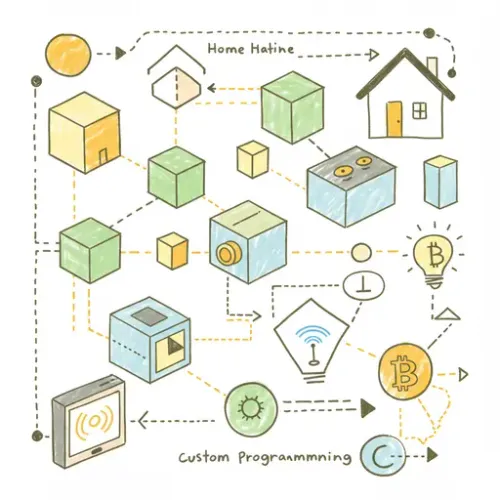Mastering Python-Powered Automations: Integrating AppDaemon with Home Assistant for Advanced Logic

NGC 224
DIY Smart Home Creator
Introduction
While Home Assistant's native automations and Node-RED excel, certain complex scenarios benefit immensely from the full power of a general-purpose programming language. AppDaemon steps in as a robust, Python-based application engine, allowing you to craft highly customizable and intricate automations. If you need advanced logic, external library integration, or simply prefer Python for its clarity and power, AppDaemon is an indispensable tool for extending Home Assistant's capabilities.
Getting Started: Installation and Basic Configuration
The simplest way to install AppDaemon is via the Home Assistant Add-on Store (for Home Assistant OS/Supervised). Search for "AppDaemon," install, and start it. For other installation methods, consult the official AppDaemon documentation.
Add-on Configuration:
In the Add-on's "Configuration" tab, you'll primarily edit appdaemon.yaml. A minimal configuration:
appdaemon:
time_zone: Europe/London # Your local time zone
latitude: 51.5 # Your latitude
longitude: -0.1 # Your longitude
elevation: 20 # Your elevation in meters
log_level: INFO
homeassistant:
url: http://homeassistant.local:8123 # Or your Home Assistant IP/URL
token: YOUR_LONG_LIVED_ACCESS_TOKEN # Generate in HA Profile -> Long-Lived Access Tokens
logs:
main_log:
filename: /config/appdaemon/appdaemon.log
apps:
app_dir: /config/appdaemon/apps
Important: Generate a Long-Lived Access Token in your Home Assistant user profile for AppDaemon's secure authentication. Replace YOUR_LONG_LIVED_ACCESS_TOKEN. After configuring, restart the add-on and check its logs for connection success.
Core Concepts: Your First App
AppDaemon apps are Python files in your apps directory (e.g., /config/appdaemon/apps). Each app is a Python class inheriting from hassapi.Hass. The initialize() method runs on startup/reload, used for setting up listeners.
Create apps/hello_toggle.py:
# apps/hello_toggle.py
import hassapi as hass
class HelloToggle(hass.Hass):
def initialize(self):
self.log("Hello from AppDaemon: HelloToggle app loaded!")
self.listen_state(self.light_control_callback, "input_boolean.test_light_toggle")
def light_control_callback(self, entity, attribute, old, new, kwargs):
if new == "on":
self.log(f"{entity} turned ON. Turning on light.your_lamp.")
self.call_service("light.turn_on", entity_id="light.your_lamp") # Replace with your light
elif new == "off":
self.log(f"{entity} turned OFF. Turning off light.your_lamp.")
self.call_service("light.turn_off", entity_id="light.your_lamp") # Replace with your light
Then, define it in /config/appdaemon/apps/apps.yaml:
# apps/apps.yaml
hello_toggle_app:
module: hello_toggle
class: HelloToggle
Restart AppDaemon. Toggle input_boolean.test_light_toggle in Home Assistant to see the automation in action and observe AppDaemon's logs.
Key AppDaemon Methods:
self.listen_state(callback, entity_id, **kwargs): Triggerscallbackon entity state change.self.listen_event(callback, event, **kwargs): Triggerscallbackon Home Assistant event.self.run_in(callback, delay, **kwargs): Runscallbackafterdelayseconds.self.call_service(domain.service, **kwargs): Calls a Home Assistant service.self.get_state(entity_id, attribute=None): Retrieves entity state or attribute.self.log(message): Logs messages to AppDaemon's logs.
Advanced Logic: Smart Lighting Example
AppDaemon excels at combining multiple conditions and handling timers. Consider a smart lighting automation:
# apps/smart_hall_light.py
import hassapi as hass
class SmartHallLight(hass.Hass):
def initialize(self):
self.log("Smart Hall Light app started.")
self.listen_state(self.motion_detected, "binary_sensor.hall_motion", new="on")
self.turn_off_timer = None
def motion_detected(self, entity, attribute, old, new, kwargs):
is_dark = self.get_state("sun.sun") == "below_horizon"
anyone_home = self.get_state("group.all_residents") == "home"
if is_dark and anyone_home:
self.log("Motion, dark, and home. Turning on light.")
self.call_service("light.turn_on", entity_id="light.hall_lights")
# Reset/create timer to turn off light after 2 minutes
if self.turn_off_timer:
self.cancel_timer(self.turn_off_timer)
self.turn_off_timer = self.run_in(self.turn_off_lights, 120)
else:
self.log("Conditions not met for turning on light.")
def turn_off_lights(self, kwargs):
self.log("Turning off hall lights due to timer.")
self.call_service("light.turn_off", entity_id="light.hall_lights")
self.turn_off_timer = None
Add to apps.yaml: smart_hall_light_app: module: smart_hall_light class: SmartHallLight. This app turns on lights only if it's dark and someone is home, and schedules a turn-off, which is reset by subsequent motion triggers.
Best Practices for a Reliable Ecosystem
- Code Organization: Keep each logical automation in its own Python file/class. Use
apps.yamlfor simple enabling/disabling. Consider alibdirectory for reusable functions. - Error Handling & Logging: Use
try-exceptblocks. Leverageself.log()extensively and monitor AppDaemon's logs via the add-on. - State Management: Be judicious with state changes. Ensure your logic handles concurrent triggers gracefully.
- Timers & Debouncing: Always store and manage timer handles (e.g., from
run_in) to cancel or reset them, preventing redundant actions. - Configuration & Secrets: Avoid hardcoding secrets. Pass them as arguments in
apps.yamland reference Home Assistant'ssecrets.yaml. Access viaself.args["your_arg"]. - Testing: Manually trigger entities and check AppDaemon logs for verification. Start simple, then add complexity.
- Updates: Keep AppDaemon updated for features, bug fixes, and security.
Conclusion
AppDaemon empowers Home Assistant users with Python's versatility for advanced automations. It's ideal for intricate logic, custom integrations, and scenarios where native automations fall short. By embracing AppDaemon, you gain unparalleled flexibility and control, elevating your smart home to new levels of intelligence and responsiveness.

NGC 224
Author bio: DIY Smart Home Creator
